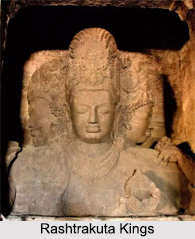 The Rashtrakuta`s empire was the most powerful of the time. They ruled from Lattaluru (Latur), and later shifted the capital to Manyaketa (Malkhed).The encouragement that several Rashtrakuta kings provided to education and literature is unique, and the religious tolerance exercised by them was exemplary. Rashtrakutas were great patrons of art and architecture. Krishana I, built the Kailasa Temple at Ellora. The caves at Gharapuri (Elephanta near Mumbai) were also built by this dynasty.Dantidurga laid the foundation of Rashtrakuta empire and Krishana III was the last great king of Rashtrakuta dynasty.
The Rashtrakuta`s empire was the most powerful of the time. They ruled from Lattaluru (Latur), and later shifted the capital to Manyaketa (Malkhed).The encouragement that several Rashtrakuta kings provided to education and literature is unique, and the religious tolerance exercised by them was exemplary. Rashtrakutas were great patrons of art and architecture. Krishana I, built the Kailasa Temple at Ellora. The caves at Gharapuri (Elephanta near Mumbai) were also built by this dynasty.Dantidurga laid the foundation of Rashtrakuta empire and Krishana III was the last great king of Rashtrakuta dynasty.
Dantidurga: Dantidurga (735 - 756) C.E. also known as Dantivarman or Dantidurga II was the originator of the Rashtrakuta realm.
Krishna I: Dantidurga`s uncle, Krishna I (756 - 774) C.E. undertook the authority of the budding Rashtrakuta empire in 757 by overpowering the last king of theChalukyas of Badami Kirtivarman II.
Govinda II: Krishna I succeded to the throne by Govinda II (774 780) C.E.
The emperor is identified for his incursion of Vengi and the vanquish of Eastern Chalukya king Vishnuvardhana IV, during the presence of his father Krishna I.
Dhruva Dharavarsha: One of the most proficient rulers of the Rashtrakuta dynasty, DhruvaDharavarsha (780-793) C.E. succeeded to the throne, subsequent to his older brother Govinda II.
Govinda III (793 - 814) C.E. He was a celebrated Rashtrakuta king who succeeded his eminent father Dhruva Dharavarsha.
Amoghavarsha I: Amoghavarsha I (800-878) C.E. was one of the utmost monarchs of the Rashtrakuta dynasty.
Krishna II: Krishna II (878 - 914) C.E. succeeded Amoghavarsha I, subsequent to his demise. In Kannada, he was named Kannara.
Indra III: Indra III (914 - 929) C.E., the grandson of Krishna II and son of Chedi princess Lakshmi, turned the emperor of the kingdom owing to the premature demise of his father Jagattunga.
Govinda IV: Govinda IV (930 - 935) C.E. the younger brother of Amoghavarsha II became the Rashtrakuta king in 930 as illustrated in the Kalasa record of Chikmagalur.
Amoghavarsha III: Amoghavarsha III (934 - 939) C.E., the younger brother of Indra III, also identified as Baddiga. wThe emperor attained supremacy with the assistance of King Arikesari of Vemulavada in Andhra and other feudatories who rebelled against him.
Krishna III: Krishna III (939 - 967 C.E.) was the utmost combatant and a proficient emperor. An astute supervisor and dexterous military campaigner, he waged several battles to retain the lost glory of the realm and played a vital role in reconstructing the Rashtrakuta Empire.
Khottiga Amoghavarsha: The decline in the Rashtrakuta empire set in. The Paramara King Siyaka II ransacked Manyakheta and Khottiga passed away skirmishing them.
Karka II: Karka II ascended Kottigga Amoghavarsha to the Rashtrakuta throne. He comprised of military triumphs in opposition to the Cholas, Gurjaras, Hunas and Pandyas and his feudatory, the Western Ganga Dynasty King Marasimha II overpowered the Pallavas.
Indra IV: Indra IV (973 - 982) C.E., was the nephew of the emperor of Western Ganga Dynasty and the last king of the Rashtrakuta dynasty.



















